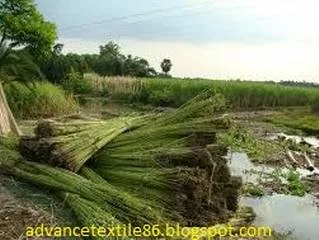Jute cultivation process
To
increase jute, farmers spread seeds on cultivated soil. When the plants are
around15-20 cm tall, they are thinned. About four months after planting, the
harvest begins. Trees are usually cut before flowering. The stalks are cut
close to the ground. The stalks are tied in bundles and soaked in water for
about 20 days. This process softens the tissues and breaks the hard pectin bond
between the busts and allows the process to separate the fibers. It is then
stripped from the stalk of the long strand and washed in clean, flowing water.
They are then hung or spread on the roof to dry. After 2-3 days of drying, the
fibers are bound in bundles.
The
climate suitable for jute growth is a warm and humid climate, which is provided
by the monsoon climate in the fall season immediately after the summer.
Temperatures above 25 ˚ C and relative humidity of 70% -90% are favorable for
successful cultivation. Additional requirement during jute sowing is 160-200 cm
rainfall per week. River basins or waterlogged or loamy soils are best for jute
cultivation. Cultivation of jute in red soil may require high doses of
fertilizer and the best pH range of 4.8-5.6 is required for its cultivation.
Ideal for plain or soft or lowland jute cultivation. As jute seeds are small in
size, the land should be prepared for fines, which can be carefully tied to the
land.
Different defects/faults in jute fiber
There are different types of defects found in jute fiber. Such as below-
Rooty Jute: This problem occurs due to improper retting underwater. These faults see on the root end area in jute.
Specky jute: These defects occur due to
insufficient washing which causes the outer barks to adhere to some places. Speck in jute is a
major defect that lowers the quality of Jute fibers.
Dazed fibers: These defects see on jute
fiber due to over-retting in water, for this reason, jute fiber loses strength
and luster and becomes bad for spinning.
Runners: Runner is a defect where a long and hard barky ribbon of fibers remains in jute fiber.
Hunka: Hunka is a jute defect, for
this reason, jute show hard and barky.
Mossy jute: Fibres from short plants that
cannot be properly steeped and cleaned contain broken pieces of jute sticks etc.
Copy
Jute: This defect is shown at the top end of the fiber. For this reason, the top end of the
fiber becomes rough and hard. These defects usually occur due to careless
steeping.
Knotty
jute: This
type of defect in jute fibers is caused by insect bites or punctures.
Flabby
or hairy jute: These defects occur due to careless stripping, fiber
loses firmness, and becomes flabby and hairy.
Heart
damage: These
defects occur when jute fiber contains excess moisture in the baled and bale center
becomes badly tendered and in some cases, fibers are reduced to powder.










0 Comments